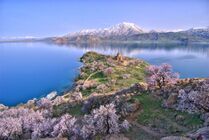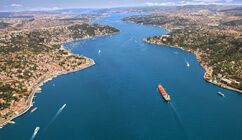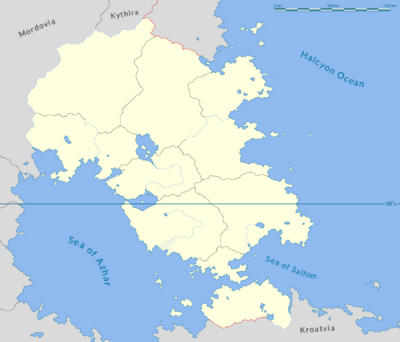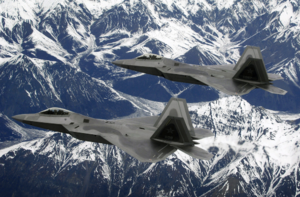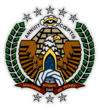Veltria
This article is incomplete because it is pending further input from participants, or it is a work-in-progress by one author. Please comment on this article's talk page to share your input, comments and questions. Note: To contribute to this article, you may need to seek help from the author(s) of this page. |
Sanctified Dominion of Veltria Sanctifié Domaine de Veltria (Veltrian) | |
|---|---|
| Motto: Annuit cœptis (Latin)
"God favors our undertakings" National Ideology: Astąhvist Unitism | |
| Anthem: En union à travers les âges (Veltrian) ”In Union Through the Ages” | |
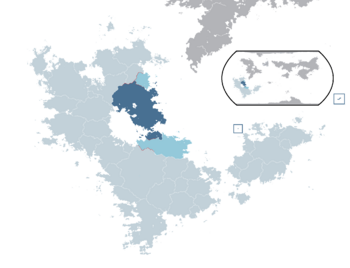 Veltria (dark blue) and its protectorate states (blue) on the continent of Aslaria (light blue). | |
| Capital | Amlaís |
| Largest city | Vontíris |
| Official languages | |
| Recognised regional languages | |
| Ethnic groups (2020) | |
| Religion | Astąhvism |
| Demonym(s) | Veltrian |
| Government | Unitary One-Party Theocratic Republic |
• Consul | Valik Sindaris |
• Praetor | Liza Erviam |
| Paria Talsyn | |
| Mikas Jianis | |
| Legislature | Supreme National Congress |
| Collegium of Apostles | |
| Veltrid Senate | |
| Establishment | |
• Athrinian Conquests | 778 BCE |
• Formation of the Amlaíite Dominion | 496 BCE |
• Veltrid Kritarchy | 217 BCE |
• Salusian Union | 682 CE |
• Republic of Aylania | 1284 CE |
• Veltrian Empire | 1794 |
• Reorganized into the Aylanian Federation | 26 April 1946 CE |
• Unitist Revolution | 10 November 2000 CE |
• Formation of the Sanctified Dominion | 18 December 2000 CE |
| Area | |
• Total | 2,257,161 km2 (871,495 sq mi) |
• Water (%) | 7.7 |
| Population | |
• July 2021 estimate | 112,309,727 |
• 2023 census | 112,8332,835 |
• Density | 11.9/km2 (30.8/sq mi) |
| GDP (PPP) | 2023 estimate |
• Total | $2.9 trillion |
• Per capita | $25,816 |
| GDP (nominal) | 2023 estimate |
• Total | $2.85 trillion |
• Per capita | $25,371 |
| Gini (2023) | 31.6 medium |
| HDI (2018) | very high |
| Currency | Díali (DIL) |
| Time zone | UTC+1 to +3 (ECT) |
| Driving side | right |
| Calling code | (+ 310) |
| ISO 3166 code | VLT |
| Internet TLD | .vl |
The Sanctified Dominion of Veltria (Veltrian: Sanctifié Domaine de Veltria - Latin: Dominium Sanctificatum Veltriae) (commonly referred to as Veltria, the Sanctified Dominion, Veltrian Dominion, and the S.D.V.) is a unitary one-party theocratic republic located on the Aslarian continent. Situated in what was once the heartland of the ancient Amlaíite Dominion, the Sanctified Republic also claims limitedly recognized territorial hegemony over the “Magisterial Protectorates” of Kythira and Kroatvia in northern and mid-eastern Aslaria respectively, and administers a military outpost on the Akkasti Islands. Bordered to the east by the Halcyon Ocean, and to the west by the Sea of Azhar, Veltria's only land borders are shared with the People’s Democratic Republic of Kythiria and the Principality of Mordovia in the north, and the Kroatvian Republic in the south. Comprised of a land area of 2,257,161 km2 (871,494 sq mi), Veltria is the largest nation on the Aslarian continent, and seventh largest in Undria by landmass. With 112.8 million inhabitants, Veltria is also Aslaria’s most populous nation, and the only nation on the continent that controls access through the Strait of Sauralis.
Veltria is home to one of the world’s oldest civilizations. First settled by nomadic tribes 8,000 years before the founding of the ancient city of Amlaís, the plains along the western Orientalis peninsula emerged as the home of several diverse polities by the end of the 9th century BCE. First united through the military conquests of the Athrinians, the region would be later ruled by the Amlaíite Dominion, which from 496 to 217 BCE continued to expand into neighboring lands – eventually encompassing a territory spanning from the Sassani Ocean in the north, to the Asyran river valley in the south. Overtaken in an internal coup by Astąhvist religious leaders in the 3rd century BCE, the Amlaíite Dominion gave way to the Veltrid Kritarchy, which ruled the Dominion’s former territories for nine centuries, and contributed to a period of significant artistic and scientific advancement known as the Veltrid Golden Era. Effectively assimilating most of the polities and cultures on the Oriantalis by the 4th century CE, the Kritarchy era largely laid the foundation for a culturally and religiously homogenous “Veltrian” society.
A series of civil conflicts and devastating wars with the Ezhari Empire during the early 5th century CE however rapidly weakened the Kritarchy, and it eventually succumbed to the expansionist conquests of the Salusian Union in 682 CE. Rule by secular nobility was restored in the Salusian period, but most of the institutions and administrative traditions that characterized the Veltrid era were preserved and adopted by the ascendant Salusian elite. A Veltrian rebellion six centuries later in 1284 allowed many of the Union’s territories in northern Aslaria to break away, subsequently leading to the formation of the Republic of Aylania, and a reestablishment of Veltrian home-rule. Conflicts with great seafaring powers in Efia by the late 18th century led to the republic’s transformation into the Veltrian Empire under Saulius Vesaiti. Veltria reached its territorial and military zenith during the Vesiatic Wars, but was eventually defeated by the combined forces of the Sixth Coalition. The restoration of the republic marked a period of steady decline and a tumultuous succession of governments in the late 19th century – brought on by the pains of industrialization, post-war territorial losses, and social liberalization championed by progressive administrations
The disastrous repercussions of the Federation’s participation in the War of Krumaarian Succession, and fears of encroaching Vogrian socialism, led to the formation of an organized and politically robust Astąhvist authoritarian movement by 1950. Under the charismatic leadership of Arturs Vectirāns, the Unitist Party emerged in 1975 – garnering public support for institutional reformation and the preservation of traditional Astąhvist values. Further destabilizing the Federation by maneuvering in and out of several coalition governments, the Unitist Party eventually used the disputed 2000 Presidential election to effectively seize power in a coup d’état – overthrowing the Aylanian federal government and establishing the Sanctified Dominion of Veltria as a single-party, theocratic state.
Longstanding animosity between Veltria’s nationalist government and several major international powers, particularly the Latin Empire and the Vogrian Federative Socialist Republic, has left the Sanctified Dominion comparatively isolated on the international stage. Relations with its communist northern neighbor, the Democratic Republic of Kythiria, have remained sour since the 2002 Veltrian invasion of Psalia. The Sanctified Dominion’s alleged support for separatist and terrorist cells operating in Kythira has also further isolated the theocratic regime, though the country’s leaders continue to wield strong influence over the nearly 800 million Astąhvists both within Aslaria and across the globe.
Long considered a nation of great geostrategic importance because of its control of the Strait of Sauralis, as well as its domination of the oil-rich Sea of Azhar, Veltria ranks as one of the largest regional trading powers on Aslaria, and has consistently been a leading economic force in Undria since industrializing in the early 20th century. The country boasts significant reserves of rare earth minerals in the Vosges Mountains, as well as a burgeoning industrialized sector focused intensely on technical hardware manufacturing and research. Though primarily a regional power, Veltria wields considerable influence over international security issues and energy policy in Undria. Amlaís, the country’s capital and second largest city, is the ancient seat of the Veltrid Magisterium, and remains a leading center of economic and cultural exchange in Aslaria. The city also boasts one of the lowest overall urban crime rates in the world, despite dealing with a rising population living beneath the national poverty line.
Veltria is a member of the Aslarian Economic Community, the Undrian Regional Council (URC), and a leading signatory of the Akkria Mutual Assistance Pact. Veltria’s longstanding cultural legacy has been further reinforced by the designation of twelve Global Heritage Sites by the URC within its borders. Its unique political system, based on the 2000 Code of Republican Union, blends elements of a unitary republic with a single-party Astąhvist theocracy dominated by the country's magisterial clergy. Veltrians, the ethnic descendants of the Amlaíites, constitute a vast majority of the nation’s ethnic makeup, although a small number of minority ethnic and linguistic groups also exist. Most Veltrians identify as practicing Astąhvists in communion with the Veltrid Magisterium, and Veltrian (a western-Aslarian based blending of Amlayan and Old Salusian) is the official national language.
Etymology
History
Pre-History
Classical Antiquity
Late Antiquity
Medieval Era
Early-Modern Period
Veltrian Empire
War of Krumaarian Succession
Aylanian Federation
Unitist Era
Geography
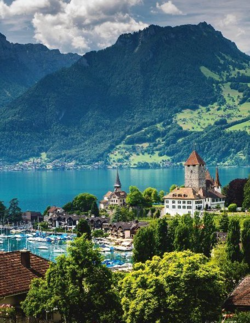
Veltria's internationally recognized territory of 2,257,161 km2 (871,494 sq mi) lies between latitudes 13° and 29° S, and longitudes and 97° and 73° W. An additional XXXXX km2 (XXXXX sq mi) is claimed by the Dominion in the neighboring regions of Kythira and Kroatvia to Veltria's south and northeast, but these "historic" claims have limited international recognition. It shares its northern border (1678 km or 1042 mi, 847 km of which runs along the Nisareaux River) with the Kythiran People’s Democratic Republic and the Principality of Mordovia, and its southern border (712 km or 442mi, consisting largely of the Asurial River and Ferrata Heights) with the Kroatvian Republic. The Halcyon Ocean borders Veltria's eastern coastline, and to the Republic's west lies the expansive Sea of Azhar.
Veltria's northern and central regions are considered some of Undria's most rugged terrain, dominated by the Karzan highlands and two large mountain ranges – the Vosges mountains, stretching from the southeastern Karzan to the Bay of Lazaris, and the Sútigor mountains stretching from central Valtrissia to the Clertreau peninsula. Mount Aylitheia, Veltria's highest point (7,543 m or 24,747 ft), is located in the Souvreaux region of the Sútigor mountains, and is the third highest mountain on Aslaria. Veltria's alpine territories and salt lakes, often closely associated with Veltrian culture, geography, and history in film and art, are mostly contained within the provinces of Essonne and Périgueux. In contrast, the Sanctified Dominion's populous coastal provinces are covered predominantly by lush riverlands and fertile foothills – with some of the nation's largest and most important population centers built along the Veltris and Estéron rivers. Three other rivers - the Elissar in northern Sivissia, Andis in southern Vitré, and Asurial in southeastern Kroatvia - also innervate the territories of the Sanctified Dominion.
Since the early conquests of the Amlaíites, Veltria and its precursors have controlled the Strait of Sauralis, through which today an estimated 28% of the global market's traded oil supply (and roughly 18% of all commercial maritime shipping) travels on an annual basis. The Dominion's largest metropolitan center, Vontíris, situated on a prominent and controlling position on the Aigle Horn, has historically been a major trading hub since the late Kritarchy period.
Climate
Veltria's climate is highly diverse. The alpine climate of the central mountain ranges along the spine of the Orientalis peninsula have encouraged settlement and growth in the region's more temperate coastal plains and riverlands ¬– particularly in the present-day provinces of Occitaine, Valtrissia, and Varia (which together, account for nearly 42% of Veltria's population). These regions boast climate conditions ranging from the hot-summer mediterranean regions in the coastal south, to the warm-summer continental climates of northern and central Valtrissia.
The Vosges mountains to the far north shield a number of population centers in Périgueux Province from blistering mid-Halcyon winds, which frequently sweep down to batter the region each year from mid-November to early-April. The riverlands of Essonne province are primarily warm and humid year-round, while the highlands of Kroatvia experience lengthy, cool winters. Veltria's eastern coast, stretching from Vaucluse in the north to Vitré in the south, experience a generally oceanic climate year-round.
Regions and Provinces
Veltria is divided into 12 regional provinces – each administered by a governor and constituent assembly elected by citizen residents for triennial terms. Veltrian provinces are further divided into counties, and subdivided into districts and municipalities. Provincial administrations rule officially through devolved powers and permissions from the central Unitist government, and are not permitted to negate or challenge national law. Provincial governorships and other state offices have existed in some form since the Kritarchy Era, but largely came into their present form following the overthrow of the Aylanian Federation – which ruled the territories as partially-independent states. The administrative reforms Consul Valik Sindaris' Unitist government in 2000 reestablished the provincial system and reorganized the nation’s local legislatures - replacing the older patchwork of state, municipal, and district councils, and centralizing local governance under Unitist Party control. In practice, most political observers note the vast majority of contemporary Veltrian lawmaking still takes place at the provincial level, albeit under the guidance of Unitist legislators. Unitist control of provincial politics, virtually unchallenged by any real opposition force in the aftermath of the Unitist Revolution, has largely mitigated serious friction points between Veltria’s provincial and national governments.
Since the Unitist agricultural and economic reforms of the mid-2000s, Veltria's urban growth rate has rapidly accelerated, with modern estimates predicting 74% of the Dominion’s population will live within the metropolitan region of a city by 2025. Varia, Occitaine, and Valtrissia provinces have seen the highest rates of internal population migration since the 1980s, with their larger job markets and more developed access to amenities being the primary motivating influencers. Home to over 16 million people, the coastal capital of Varia province, Vontíris, is Veltria's largest city by population. Along with the nation's capital, Amlaís, Vontíris is a major nexus of Veltria's national communication and transportation infrastructure, and is the home of the republic's primary stock exchange.
Amlaís, Veltria's capital and second-largest city, has itself seen its population grow at a rate between 4-6% annually since 2003, prompting major infrastructure and housing development investments from both the national government and the country's private construction sector. It is the primary cultural nexus of the Sanctified Dominion, nestled along the Veltris River in the foothills of the Sútigor mountains, and the location of many of the holiest sites in the Veltrid Astąhvist faith (including the Asklerian Sanctum and the Palace of the Prophet).
Ascareaux, with just under 7.9 million inhabitants, is Veltria's third-largest city, and the capital of the fertile Occitaine province. Situated on Lake Gravona, Ascareaux historically used its natural access to the Estéron River to exert political control over the region's surrounding floodplains, which have for centuries served as the vital breadbasket of the Orientalis peninsula. Prior to the Amlaíite era, the city served as the cultural and political capital of the Ascalid Kingdom - one of the many coastal polities brought under the Dominion's influence in the 5th century BCE. Ascareaux’s twin city at the end of the Estéron, the port of Nièvre on the Sea of Azhar, is also a major trade and industrial hub in Occitaine - home to the Chantier docks and the Varagno shipyards.
| Name | Flag | Seal | Capital | Governor | Total area | Land area | Population | Number of Senate Seats | Abbreviation | GRP in million Díali (2016) | GRP per capita in Díali (2016) | ||
|---|---|---|---|---|---|---|---|---|---|---|---|---|---|
| km2 | mi2 | km2 | mi2 | ||||||||||
| Périgueux | Charlotte Bisset (AVP) | 298,938 | 115,421 | 282,782 | 109,183 | 7,420,000 | 30 | PER | (D) XXXXXX | (D) XXXXXX | |||
| Arles | Aurnold Deschamps (AVP) | 23,691 | 9,147 | 17,726 | 6,844 | 4,431,000 | 18 | ARL | (D) XXXXXX | (D) XXXXXX | |||
| Occitaine | Claire Laprise (AVP) | 243,773 | 94,121 | 239,192 | 92,353 | 10,690,000 | 43 | OCN | (D) XXXXXX | (D) XXXXXX | |||
| Kroatvia | Sasha Auriel (AVP) | 162,516 | 62,748 | 159,281 | 61,499 | 11,720,000 | 47 | KRO | (D) XXXXXX | (D) XXXXXX | |||
| Varia | Lelia Malfroy (AVP) | 89,383 | 34,511 | 88,933 | 34,337 | 26,680,000 | 107 | VAR | (D) XXXXXX | (D) XXXXXX | |||
| Essonne | Kamrin Leliévre (AVP) | 396,267 | 153,000 | 395,844 | 152,836 | 6,260,000 | 26 | ESO | (D) XXXXXX | (D) XXXXXX | |||
| Nazaire | Etiard Royce (AVP) | 19,482 | 7,522 | 16,264 | 6,280 | 4,410,000 | 18 | NAZ | (D) XXXXXX | (D) XXXXXX | |||
| Vaucluse | Ervin Vaige (AVP) | 153,486 | 59,261 | 140,113 | 54,098 | 5,820,000 | 23 | VAU | (D) XXXXXX | (D) XXXXXX | |||
| Vitré | Pierre Naspard (AVP) | 297,945 | 115,037 | 283,928 | 109,625 | 8,650,000 | 35 | VIT | (D) XXXXXX | (D) XXXXXX | |||
| Sivissia | Emiline Cesareaux (AVP) | 169,738 | 65,536 | 153,552 | 59,287 | 6,790,000 | 27 | SIV | (D) XXXXXX | (D) XXXXXX | |||
| Aegia | Delatairre Vectas (AVP) | 207,658 | 80,177 | 205,722 | 79,430 | 5,806,000 | 24 | AEG | (D) XXXXXX | (D) XXXXXX | |||
| Valtrissia | Vesimir Ney (AVP) | 193,279 | 74,625 | 188,727 | 72,868 | 10,910,000 | 44 | VAL | (D) XXXXXX | (D) XXXXXX | |||
Demographics
By far the largest ethnic population, Veltrians comprise roughly 67% of the country's population, forming demographic majorities across 10 of the Sanctified Republic’s 12 main provincial holdings. Veltria is also home to several sizeable ethnic minorities - incorporated primarily via the country's historic expansion during the Amlaíite and Kritarchy eras. Kroatavians and Parronise, the second and third largest ethnic groups in the country, are descendants of the tribal polities that once ruled over the southern desert and western plains of modern day Kroatvia and Aegia provinces respectively. A large Suberian community, many of whom arrived in Veltria as refugees during the 1978 Aylanian-Taijud War, is settled throughout various enclaves in the province of Khuzian, and comprise roughly four percent of the nation's total population. Though many Suberians living within Veltria today are professed Astąhvists, the vast majority adhere to the Shanshari branch of the Iskshuri sect. They however remain a protected religious minority by decree of the Unitist government. While Veltria's population is comparatively large to its neighbors in Aslaria, the nation's large territorial size has fostered relatively low population density (though it is considerably higher for more developed regions).
Decimated by the Red Plague in the 1700s, Veltria's population has since recovered slowly over three centuries of development, climbing to a new peak in 2014, with 112.3 million inhabitants. The Aylanian Federation’s wartime conflict with the Kroatvian Republic and its Efian allies during the 1938-1947 War of Krumaarian Succession crippled critical agricultural infrastructure in the country's fertile southwestern provinces - indirectly leading to the starvation of an estimated 850,000 Veltrians, Kroatavians, and Parronise over the final two years of the war. Mass starvation in the barren northern provinces, which relied heavily on food supplies from the south, drove a significant migration to the more temperate territories till the calming of hostilities towards the late 1940s. In the mid 1950s however, focused rebuilding efforts and family protection programs encouraged population growth across the nation once again. Following the Unitist Revolution in 2000, the new Astąhvist government presided over a national "Era of Rebirth" - encouraging the raising of new families through a series of social reforms and overhauling the nation's agricultural infrastructure. By the mid-2000s, the reforms had been credited with yielding a growth of the national population by 34%, and a tripling of the Republic's agricultural output in the later war years. Since 2015, Veltria's population has continued to increase, though analysts have noted at a comparatively lower rate. A continued drop in death rates and improved birth rates still contribute to the nation's overall growth, but slowed immigration, as well as an increasing preference of Veltrians to raise smaller families, have had a moderating effect on population growth.
With roughly 11.3 births per 1000 people recorded in 2016 data, Veltria's birth rate is higher than those of most Undrian countries. Predictions made by the Institute for National Health that Veltria’s birth rate will slow to approximately 10.6 births per 1000 over the next 10 years appear due in part to rising cost of living in urbanized Veltrian regions - driven particularly by education and housing. Despite fluctuations in growth, as well as strong international resistance, the Veltrian government remains implacably opposed to the widespread distribution and use of contraception, demonstrated most recently in a 2013 move by the Apostolic Assembly to block a legislative initiative, led by the National Reformist Caucus in the Veltrid Senate, to legalize the possession, distribution, and use of certain forms of contraception (including condoms, birth control implants, and ingested pills). The controversial measure was supported internationally by the Federal Republic of Auraliae, as well as numerous social-reform advocates in Veltria seeking to loosen the grip of the Veltrid Magisterium over domestic politics. From 2010 to 2014 however, monthly government child-assistance payments were doubled for low-income families in the 20th tax percentile and below - an initiative spearheaded by the Principlist wing of the Unitist Party, and passed with the support of the Apostolic Assembly.
Declining immigration rates prompted the government to enact several reforms in 2008 to simplify access to Veltrian citizenship. Following the 2008 "Immigration Reform Act," Astąhvists abroad seeking to obtain Veltrian citizenship may apply for expedited temporary resident status, and receive full citizenship upon completion of one of the nation's civil service programs. An amendment to the act, attached by the Principlist wing in the Veltrid Senate, stipulated however that this offer of full citizenship was contingent on the renunciation of allegiance to all other foreign powers, and forfeiting all other citizenships.
Largest cities or towns in Veltria
Ascerit National Statistical Center: Results of national census, 2016 | |||||||||
|---|---|---|---|---|---|---|---|---|---|
| Rank | Province | Pop. | Rank | Province | Pop. | ||||
 Vontíris  Amlaís |
1 | Vontíris | Varia | 16,118,138 | 11 | Vepilnis | Khuzian | 1,193,475 |  Ascarit  Aizkoria |
| 2 | Amlaís | Valtrissia | 8,291,824 | 12 | Aralosk | Lakkari | 1,121,985 | ||
| 3 | Ascarit | Cibariz | 7,871,200 | 13 | Leriki | Malgir | 1,023,174 | ||
| 4 | Aizkoria | Kroatvia | 5,752,259 | 14 | Saurikesh | Aegia | 1,014,187 | ||
| 5 | Varzil | Varia | 4,420,190 | 15 | Ustrai | Kova'ar | 819,377 | ||
| 6 | Akkria | Alkisar | 3,358,400 | 16 | Aytalia | Aibariz | 729,121 | ||
| 7 | Smarilis | Valtrissia | 2,604,858 | 17 | Sorica | Kroatvia | 459,818 | ||
| 8 | Tareslejas | Sivissia | 2,310,472 | 18 | Arezalnis | Lakkari | 318,191 | ||
| 9 | Velmaris | Sirnai | 1,271,300 | 19 | Varziantalnis | Aegia | 240,715 | ||
| 10 | Yimlan | Cibariz | 1,218,581 | 20 | Ragana | Malgir | 210,871 | ||
Government
The Veltrian government, formed by 1956 Constitution, is officially a unitary theocratic republic - composed of an intricate collection of governing bodies, divided conventionally into institutions that exercise executive, legislative, and judicial powers. Separated into civilian and clerically-administered sectors, ultimate "custodianship" of the nation rests in the person of the Hierarch, who is charged with overseeing the country's national interests, while the day-to-day management of the country's legislative work and civil administration are entrusted to an elected legislature and various civilian institutions. Though governing power has historically been highly centralized in some form of national government for much of Veltria's history, a measure of legislative authority has been gradually granted to provincial assemblies in the decades since the 1956 Unitist Revolution, while municipal councils have been extensively involved in local governance and the maintenance of public order since the early years of the Imiri Vizierate in the late 12th century.
Executive

Under the constitution ratified in the aftermath of the 1956 Unitist Revolution, the Hierarch (or Májiskoi in native Veltrian) of the Veltrid Astąhvist Magisterium is the Sanctified Republic's ex officio head of state and commander-in-chief of the armed forces. In addition to his or her primary role as High Prophet of the Veltrid sect of the Astąhvist faith, the Hierarch serves as the ‘’Mahraji’’ of the Holy City of Amlaís (an honorary title reserved for the Prophet), and the head of the Sacred Veltrid Dar. As a general term (coming from the transliterated ancient Imrinaic term for "door"), the "Sacred Dar" represents not only the temporal power of the Hierarch, but also his spiritual and pastoral authority over religious and civil matters. The Prophet serves a life term following his election by the Collegium of Sages during Kapal'shrir, and may not be removed from office after his ascension to the Hierarchate (though voluntary resignation is legally permitted). The office wields broad administrative powers, including the right to issue Prophetic "Juridicti" that carry the full force and effect of national law (when so stipulated), and the power to declare war and offer peace. Despite this official concentration of authority, Veltrian Prophets have largely delegated most powers to legislative procedure and civilian oversight. Hierarch Khosri V, born Darius Imran Al'khil, was elected on the 19th of May, 2014. Prior to his election, Councillor Al'khil served as the Councilor of Foreign Affairs, and has since become a polarizing figure in Undria. Hierarch Khosri's vigorous focus on serving the poor and marginalized portions of Veltrian society was seen as the primary initial focal point of his hierarchate until international events largely overshadowed most of his domestic work. A civil uprising in the Emirate of Iskasha'ar, sparked by the disputed results of the country's 2015 presidential election, kicked up an international firestorm which saw a major falling out between the Sanctified Republic and its southern neighbor, the Kingdom of Hashabia. Among more positive circles, Prophet Khosri is regarded as a champion of religious self-determination and a protector of Astąhvist communities around the region. Less enamored observers have frequently characterized his military exploits in Iskasha'ar as that of a "hapless warmonger," driven by a misguided "holy warrior" mentality, and a dangerous sense of "Veltrid supremacism".
Veltrid Senate | |
|---|---|
| 289th Session | |
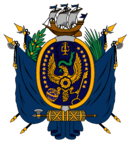 Senate Seal | |
| Type | |
| Type | Lower House of the Supreme Republican Congress |
Term limits | None |
| History | |
| Founded | 25 December 2000 |
| Leadership | |
Majority Leader | |
Minority Leader | |
| Structure | |
| Seats | 470 |
 | |
Political groups | AVP National Coalition (356)
AVP Popular Coalition (162)
|
| Elections | |
| Proportional | |
| Meeting place | |
 | |
| Palace of the Nation Amlaís, Valtrissia | |
| Website | |
| senate.vel.gov | |
Legislature
The Veltrid Senate, a 470-member chamber of elected representatives, serves as the national legislature. 442 senators are elected sexennially to represent single-member districts containing approximately 250,000 citizens. "Resizing," a process by which constituent districts are redrawn according to population, is conducted every twenty years following the national census. Two senators are elected specifically to represent the capital, Amlaís, while 16 senators are elected from overseas territories. An additional 10 senate members are directly appointed by the Hierarch. At the beginning of each new session, the Veltrid Senate nominates a State Vizier from among its members to serve as the nation's head of government and highest civil authority under the Hierarch. After nomination, the nominee must be approved by at least three members of the Guardian Standing Committee, and not opposed by more than four (the nominee may also be confirmed by direct appeal to the Hierarch). As "first citizen of the state," the State Vizier is responsible for the day-to-day executive management of the government's civil responsibilities, and appoints a Cabinet of Ministers to oversee various national departments and agencies. The State Vizier is not, however, empowered to interfere with the internal administration of the Magisterium, and may not influence or direct changes to the powers of the Hierarch - who reserves supreme authority over all matters of state. Additionally, several key government departments and agencies fall specifically under magisterial control - most notably, the Ministry of Foreign Affairs (administered by a Majir, or "Sage," appointed by the Hierarch), and the Institute for the Advancement of the Sacred Vision, whose leadership is exclusively controlled by religious authorities. Veltria's 1956 constitution delegates several powers to the Veltrid Senate, including the powers to draft legislation, approve budget proposals, and ratify treaties with foreign nations. "Magisterial Assent" however, is required for legislation to become law.
Guardian Standing Committee
To facilitate Magisterial Assent, a Guardian Standing Committee consisting of 12 Majiri is charged with the review of all legislative proposals passed by the Senate. The GSC may only veto legislation by unanimous agreement, though it is empowered to attach "mandatory amendments" to proposed legislation. Such amendments, carrying the support of two thirds of the Sages on the committee, function as editorial prerequisites for a bill's enactment. The amended bill, if not challenged by the Senate over a period of ten days, becomes law. If the Senate challenges the amended bill, it may move to the floor for debate again, followed by a "nullification" vote. A four-fifths vote may override a GSC-amended bill, but it must be sent to the High Prophet for final enactment. At any time, the Senate or GSC may appeal to the Prophet to strike down or approve the law. The GSC is also responsible for vetting and approving candidates for political office appointments, and national elections. Citizens wishing to run as a candidate for the national Unitist Party must be reviewed by the Committee, and successfully petition the support of three Sages (and not opposed by more than four). Committee members (who serve septennial terms) are exclusively appointed by the Magisterium, with six directly appointed by the Hierarch, and six elected from within the Collegium of Sages.
The Amlaíc Içtima
Within the Veltrid Magisterium itself, a vast bureaucracy works in coordination with civilian government branches to facilitate effective governance. The Amlaíc Içtima is comprised of ten Institutes, thirteen councils, four ministries, and three tribunals. Among the most active of the major Içtima institutions are the Institutes for the Evangelization of the Peoples (IEP), which oversees the Magisterium's various missionary activities across Undria (and within the Republic itself), and the Institute for Communal Harmony (ICH), which functions as the nation's primary social aid provider. Most Veltrian social welfare, job training, food stamp, and public assistance programs fall under the administration of the ICH (typically working with funds provided by the Institute for Works and Means), although standards of national healthcare fall under the jurisdiction of the National Health Council.
Legal System

The authority to appoint the nation's "Hasidjir" (or, "Chief Justice") rests with the Hierarch, who selects a candidate from a list of four. Two names are submitted by the Chairman of the GSC, and two more by the State Vizier (both the Chairman and State Vizier may concur on candidates, and stipulate such in the submitted list). In turn, the Chief Justice directly appoints the other 6 justices of the Supreme Procuratorate and the chief public prosecutor. Courts in Veltria are largely divided along secular and religious lines. For the most part, the secular courts of the nation bear the brunt of the civil cases and criminal prosecutions that make their way through Veltria's judicial system on a yearly basis. At the local level, 112 District Courts administer justice for both criminal and civil cases. Decisions made at the district level may be appealed to one of 17 Circuit Courts, which have appellate jurisdiction over specific regions across the country. At the highest civil level, the 7-judge panel of the Supreme Procuratorate, exercises total authority to reconcile discrepancies (constitutional or otherwise) between decisions made by Circuit Courts.
Under Veltria's 1956 constitution, several religious courts within the Veltrid Magisterium also exersize various forms of judicial power. Legal disputes on religious matters are brought before magisterial courts, officially convened by a Zaidir, but typically administered by a designated local religious jurist. Decisions by magisterial courts may be appealed to one of 13 Venerate Courts (one for each province, and one for Veltria's overseas territories), which are each overseen by three appointed Venerate Judges. These courts fall under the supreme jurisdiction of the Harmonic Tribunal, which functions as the highest appellate and administrative court of the Velrid Magisterium. The Harmonic Tribunal both oversees and regulates the legal framework that innervates the Amlaíc Içtima's administration, and wields broad authority to provide oversight on the administrative decisions of magisterial officials.
The Superior Inspections Court deals primarily with matters of conscience and morality - functioning as the judicial wing of Veltria's internal security service, the IVB. While magisterial courts are not empowered to hear criminal cases under normal circumstances, the Superior Inspections Court wields loose powers to conduct trials and carry out sentencing for certain categories of offenses, including: crimes endangering national security, treason, and heresy. Like the High Harmonic Tribunal, the decisions of the Superior Inspections Court are final and cannot be appealed - rendering it ultimately answerable only to the Hierarch. The Guardians' Court of Review, a sub-court of the IVB, handles crimes allegedly committed by clerics and citizens closely associated with the Veltrid Magisterium. The IVB's jurisdictional claim to legitimately investigate, detain, prosecute, and punish clerics and other magisterial officials has been the subject of considerable criticism between Astąhvist sects in Undria, particularly in cases where an alleged offending party has been a foreign national who sought refuge in his or her home country. The Superior Inspections Court generally falls under the broad categorization of an Içtima institution, though its administration and operation is largely kept separate from the Içtima itself.
Foreign relations
Military
The Veltrian military is divided into the Veltrian Army, Navy, and Air Force. In a 2009 administrative audit, the Department of Defense reported 377,000 personnel on active duty status, as well as roughly 267,000 trained reservists in the Home Guard. The Apostolic Guard, a separate regime security force answering directly to the Unitist Party, is estimated to number around 187,000 troops, divided among 11 infantry divisions, 4 armored divisions, and various independent brigades. The Sanctified Dominion also maintains a paramilitary volunteer militia known as the Citizens Vigilant, of whose 4.7 million civilian members 58,000 are uniformed active duty personnel dispersed throughout the country. In peacetime, the Citizens Vigilant operates under the direction of the SIA, though in wartime, Consular Decree may place the militia under the overall command of the Republican Guard.
Abandoning the Aylanian Federation's previous mandate compelling all male citizens aged 18–25 to serve one year of military service during the 2003 Unitist reforms, Veltria's armed forces have since consisted of strictly volunteer personnel. The Sanctified Dominion also boasts a large and fully indigenous arms industry, producing most of its own military equipment, and exporting considerable amounts of hardware to regional allies and organizations. The International Arms Overwatch Committee of the Undrian Regional Council estimated that Veltrian small arms accounted for as much as 8.7% of all internationally traded firearms in 2013. The same 2013 report concluded that other Veltrian military hardware accounted for roughly 12.2% of the Undrian arms economy.

On March 22, 1968, following a significant escalation of tensions between the Aylanian Federation and the Vogrian Federative Socialist Republic, Veltria's preceding government announced its first successful nuclear weapons test in the Rameaux desert. The announcement had followed eight years of dedicated research and development conducted under a classified program begun under the administration of President Lhora Thoreau in 1960. In spite of international pressure to denuclearize, the Veltrian Dominion continued to advance its nuclear research after the Unitist Revolution, successfully testing its first thermonuclear device over the Marmis atoll in 2004, and its Iskaran V inter-continental ballistic missile delivery system in 2010. For security reasons, the Veltrian government has repeatedly refused to disclose the number of field-capable warheads it has stockpiled for service, but international arms experts believe the Unitist regime could have as many as 211 thermonuclear devices, and a missile fleet with a maximum targeting range of 14,000km. Heavily invested in unconventional research and development defense programs as well, the Sanctified Dominion is also reported to wield one of the largest stockpiles of biological and chemical weapons claimed by any nation in Undria. Since the 2007 Havenport Conference, pressure has grown within Veltria in to reevaluate its nuclear position to alleviate constraints on the nation's economic growth due to international sanctions, but observers have noted this pressure has yet to materialize as a coherent legislative force that could overcome the coordinated protests of hardline nationalists and military figures. Veltria administers the second largest fleet of ballistic missile submarines in Undria, and operates a sizable strategic bomber force of domestically designed and produced aircraft. Veltria's ground forces, specifically its armored vehicle force, currently ranks as the largest on Aslaria, and is the third-largest conventional military force in the world.
| Branch |
|---|
The Veltrian government's longstanding refusal to publish its military expenditures has drawn the ire of several Undrian nations, particularly members of the Undrian Security Initiative (USI), which following the start of the Psalian Independence Crisis, has frequently lobbied the URC to mandate military expenditure publication for all member states. Several international think tanks estimate the Sanctified Dominion's military expenditures to fluctuate between 92 to 98 billion dialí per annum (ref. Escera Strategic Arms Institute), although they warn these figures reflect only the operating costs of Veltria's known forces and programs. Other estimations, particularly those released by the Sanctified Dominion's geopolitical adversaries, claim Veltria's military spending may be much higher. One Auralian report indicated that the operating cost of the Apostolic Guard alone may account for no less than 33 billion dialí, with the rest of the military pushing beyond 128 billion in spending. Despite the criticism, the Veltrian government continues to deny its secretive budget is used to disguise threatening programs, claiming it is instead intended to simply protect the nation's national security interests in the face of threatening international secular powers.



